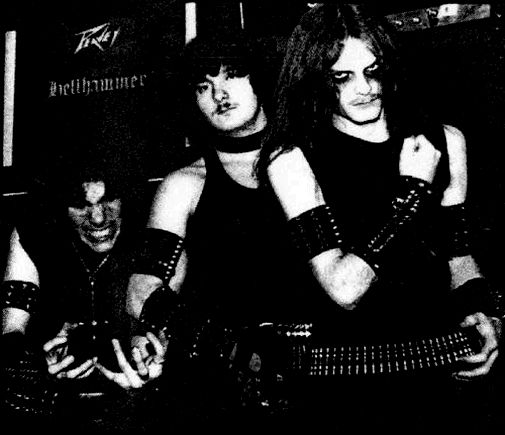
Our tribute to Hellhammer is more than a recognition of their historical importance. Rather, we understand the relevance of Hellhammer as one artistic, in terms of the development of the craft of metal, and as the time-less place of several of their compositions. In general, we can hear the band’s material broken in two directions: one is the temporal rock n’ roll influence, and the other a hint of madness, an intrusion of the unknown into the mind of Tom G. Warrior especially. It is the exploration of this unknown side that brought forth what makes Hellhammer the realization of underground metal as music, not simply as idea or as a ‘social’ movement or a ‘sub/counter’ culture. The latter two are temporal, and ultimately just by-products. What concerns us here is the dark side channeled, the a-/supra- temporal, the in-human and the un-humane making headway unbeknownst and not fully understood by the artists themselves.
Death Fiend (1983)
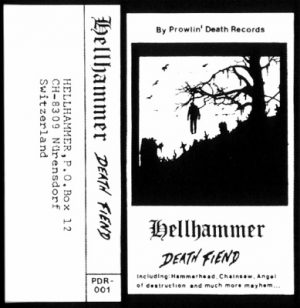
The first official demo by Hellhammer shows traces of their rock influences, hardcore punk, and perhaps even a little of Lemmy, but it shows a creative band trying to put the pieces together, thereby creating through their ownl language what would later come to comprise some of the metal ‘subgenres’. Apart from the aforementioned rock and punk sounds, there are parts in here that could perfectly be Saint Vitus songs. The parts where Hellhammer sounds ‘like’ Lemmy, ‘like’ Discharged, or ‘like’ Saint Vitus, are profficient and mostly satisfying. The best and most fascinating parts, however, come from the Hellhammer sound and riff coming through confusedly and out of control. This happens only inside the center of a vortex, like lightning flashes that surge through the body, but which do not originate in it, and which are outside the operator’s control.
Triumph of Death (1983)
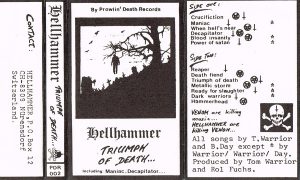 A band a rapid self-discovery, Triumph of Death sees Hellhammer start to grasp its own voice, however still clumsily and filtered. At this point, the attempts at a ‘faster’ doom, like Saint Vitus sped up, hint at Celtic Frost, perhaps telling us how that this next phase of the musicians was actually a step down from what Hellhammer eventually discovered. It is quite obvious that rather than a second demo, Triumph of Death is a full second version of Death Fiend. Rather than consciously moving away from his influences, Tom G. Warrior sounds like a re-powered, darker Lemmy, and the riffs become twisted, amalgamated versions of the triad of influences mentioned earlier. In his attempt to become a unitary flow of them, and in expressing themselves savagely in that attempt, Hellhammer create a monster. The flow of the music is improved, as Hellhammer moves towards their legendary, to those with ears to hear, capacity for transition and introduction of synthetic material.
A band a rapid self-discovery, Triumph of Death sees Hellhammer start to grasp its own voice, however still clumsily and filtered. At this point, the attempts at a ‘faster’ doom, like Saint Vitus sped up, hint at Celtic Frost, perhaps telling us how that this next phase of the musicians was actually a step down from what Hellhammer eventually discovered. It is quite obvious that rather than a second demo, Triumph of Death is a full second version of Death Fiend. Rather than consciously moving away from his influences, Tom G. Warrior sounds like a re-powered, darker Lemmy, and the riffs become twisted, amalgamated versions of the triad of influences mentioned earlier. In his attempt to become a unitary flow of them, and in expressing themselves savagely in that attempt, Hellhammer create a monster. The flow of the music is improved, as Hellhammer moves towards their legendary, to those with ears to hear, capacity for transition and introduction of synthetic material.
Satanic Rites (1983)
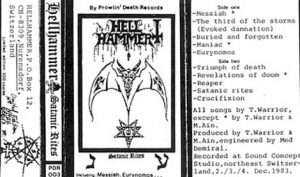
In truth, this is the 1983 Hellhammer demo. The two preceding it are just drafts towards this exciting, unabashed unleashing of the beast. Here be degeneracy and evil for their own sake, here be the toppling of the tower and the rearing of the dragon’s head, here be the onslaught of heresy. Finally, Hellhammer has found where it stands, quite distinct from any of the influences we mentioned earlier, even if we can still functionally recognize them ‘historically’, embedded in the blood-memory of the music. However, the bones of the music themselves are pure Hellhammer. What sets Hellhammer apart as actual creators is that, at the very bottom of this whole affair, they did not bring about their music by standing on the shoulders of those who came before. While the band did reach for an emulation of their idols, the stylistic clashes were pulling something out from a darkness beyond, through the entrails of the musicians. Hellhammer’s influences are not ‘lying under’, they are rather just smeared on the surface, used as tools of expression for a new gospel of sonic destruction.
Apocalyptic Raids (1984)
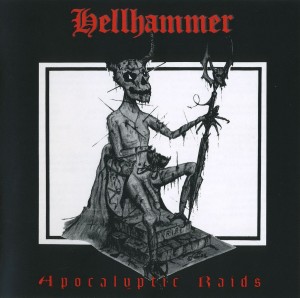
The peak of Hellhammer’s music shows us an ambivalence of intention and soul. On the one hand, in Apocalyptic Raids we find a perfected performance, and a summary, of Hellhammer’s musical proposition. On the other, we see a conscious stepping away from the more confusing aspects of the music. The face that Hellhammer presents here, as can be seen in contrast with Satanic Rites, is the one that most closely emulates its fast-paced contemporaries, allowing only the slower pace in the suave the rock-n-roll swing of ‘Triumph of Death’, the best parts of which are the uniquely Hellhammeric doom phrases and the howls. Finally, ‘Horus Aggressor’ is probably the only track here giving us a real taste of what Hellhammer hides. In the end, while an entertaining take on the dark discoveries of 1983, Apocalyptic Raids is the beginning of a sell-out move, which fortunately leaves enough of the essence to make it a solid classic. This release, however, is nowhere near as interesting, revealing or exciting as Satanic Rites.
Tags: apocalyptic raids, Black Metal, death fiend, death metal, discography, hellhammer, overview, satanic rites, triumph of death


seems kinda boring and out dated i prefer the modern tech stuff like obscura just sounds better plus better playing
The Gorguts album or the soy band?
the soy band
“Apocalyptic Raids is the beginning of a sell-out move”.
Seriously? Would you mind expanding on the idea?
I did in the article. Read again.